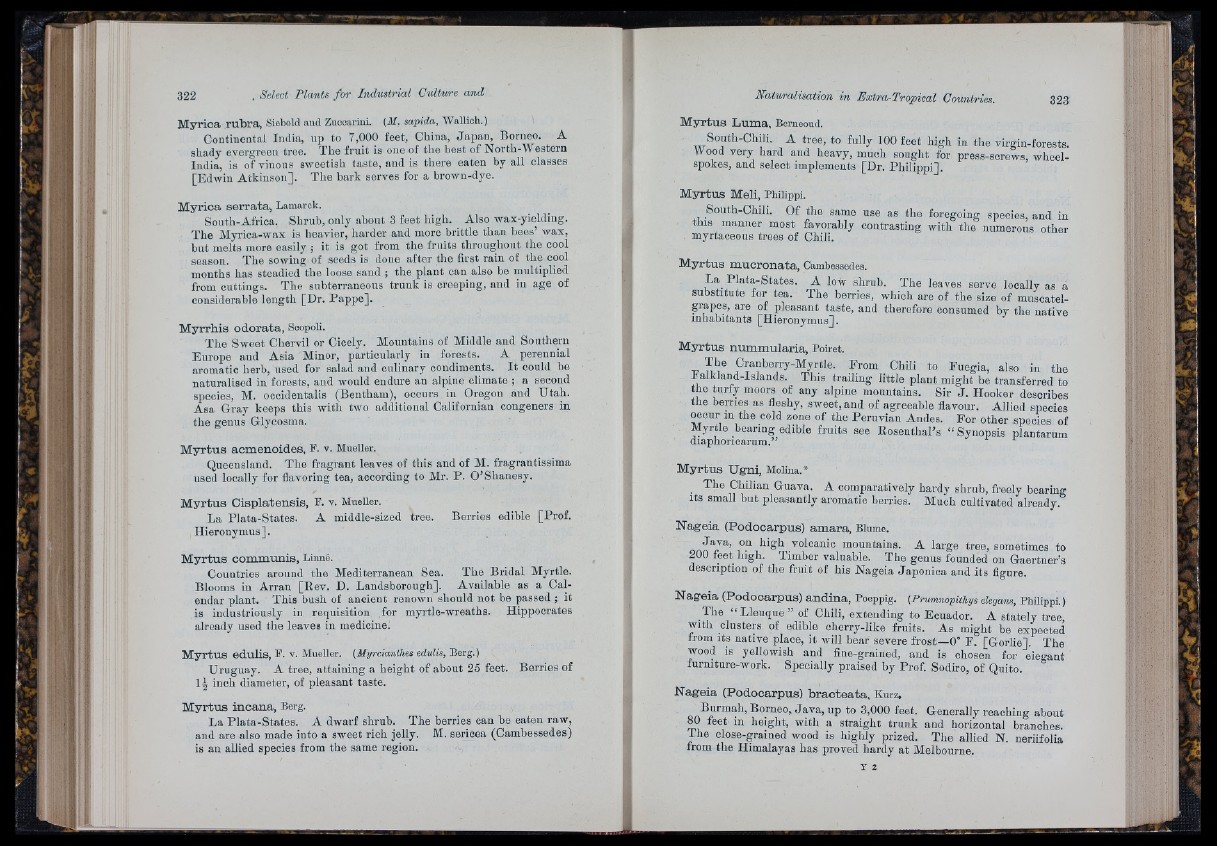
M y ric a ru b r a , Siebold and Zuccarini. (M. sapida, Wallich.)
Coutuiental India, np to 7,000 feet, China, Japan, Borneo. A
shady evergreen tree. The fruit is one of the best of North-Western
India, is of vinous sweetish taste, and is there eaten by all classes
[Edwin Atkinson]. The bark serves for a brown-dye.
M y ric a s e r r a ta , Lamarck.
Sontli-Africa. Shrub, only about 3 feet high. Also wax-yielding.
The Myriea-wax is heavier, harder and more brittle than bees’ wax,
but melts more easily ; it is got from the fruits throughout the cool
season. The sowing of seeds is done after tlie first rain of the cool
months has steadied the loose sand ; the plant can also be multiplied
from cuttings. The subterraneous trunk is creeping, and iu age of
considerable length [Dr. Pappe].
M y r rh is c d c r a ta , Soopoli.
The Sweet Chervil or Cicely. Mountains of Middle and Sonthern
Europe and Asia Minor, particularly in forests. A perennial
aromatic herb, used for salad and culinary condiments. I t could be
naturalised in forests, and would endure an alpine climate ; a second
species, M. occidentalis (Bentham), occurs in Cregon and Utah.
Asa Gray keeps this with two additional Californian congeners in
the genus Glycosma.
M y r tu s a cm e n o id e s, 3?. v. Mueller.
Queensland. The fragrant leaves of this and of M. fragrantissima
used locally for flavoring tea, according to Mr. P. C’Shanesy.
M y r tu s C isp la te n s is , F. v. Mueller.
La Plata-States. A middle-sized
Hieronymus].
tree. Berries edible [Prof.
M y r tu s c om m u n is , Linné.
Countries around the Mediterranean Sea. The Bridal Myrtle.
Blooms in Arran [Rev. D. Landsborough]. Available as a Calendar
plant. This bush of ancient renown should not be passed ; it
is industriously in requisition for myrtle-wreaths. Hippocrates
already used the leaves in medicine.
Berries of
M y r tu s edulis, F. v. Mueller. (Myrcianthes edulis, Berg.)
Uruguay. A tree, attaining a height of about 25 feet,
inch diameter, of pleasant taste.
M y r tu s in c a n a , Berg.
La Plata-States. A dwarf shrub. The berries can be eaten raw,
and are also made into a sweet rich jelly. M. sericea (Cambessedes)
is an allied species from the same region.
M y r tu s L um a , Berneoud.
Sonth-Chili. A tree, to fully 100 feet high in the virgin-forests.
Wood very hard and heavy, much sought for press-sorews, wheel-
spokes, aud select implements [Dr. Philippi].
M y r tu s Meli, Philippi.
South-Ohili. C f the same use as the foregoing species, and in
this manner most favorably contrasting with the numerous other
myrtaoeous trees of Chili.
M y r tu s m u c ro n a ta , Cambessedes.
La Plata-States. A low shrub. The leaves serve locally as a
substitute for tea. The berries, which are of the size of muscatel-
grapes, are of pleasant taste, and therefore consumed by the native
inhabitants [Hieronymus].
M s rrtu s n um m u la r ia , Poiret.
T." Cranberry-Myrtle. From Chili to Fuegia, also in the
la lkland-Islands. This trailing little plant might be transferred to
the turfy moors of any alpine mountains. Sir J . Hooker describes
tlie berries as fleshy, sweet, and of agreeable flavour. Allied species
occur m the cold zone of the Peruvian Andes. For other species of
Myrtle bearing edible fruits see Rosenthal’s “ Synopsis plantarum
diaphoricarum.’-’
Myrtus Ug-ni, Molina.*
_ The Chilian Guava. A comparatively hardy shrub, freely bearing
Its small but pleasantly aromatic berries. Much cultivated already.
N a g e ia (P o d o c a rp u s ) am a r a , Blume.
Jav a , on high volcanic mountains. A large tree, sometimes to
200 feet high. Timber valuable. The genus founded on Gaertner’s
description of the fruit of his Nageia Japónica and its figure.
N a g e ia (P o d o c a rp u s ) a n d in a , Poeppig. {Prumnopithys elegans, Philippi.)
The Lleuque ’ of Chili, extending to Ecuador. A stately tree
with clusters of edible cherry-like fruits. As might be expected
from its native place, it will bear severe frost—0” F. [Gorlie], The
wood is yellowish aud fine-grained, and is chosen for eiegant
furmture-work. Specially praised by Prof. Sodiro, of Quito.
JSTageia (P o d o c a rp u s ) b r a o te a ta , Kurz.
Burmah, Borneo, Jav a, up to 3,000 feet. Generally reaching about
80 feet in height, with a straight trunk and horizontal branches.
The close-grained wood is highly prized. The allied N. neriifolia
from the Himalayas has proved hardy a t Melbourne.